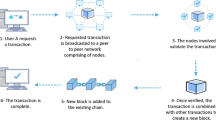Abstract
The Fintech industry has facilitated the development of companies using blockchain technology. The use of this technology inside banking system and industry opens the route to several questions regarding the business activity, legal environment, and insurance devices. In this paper, considering the creation of small companies interested to develop their business with a public blockchain, we analyse from different aspects why a company (in banking or insurance system, and industry) decides that a blockchain protocol is more legitimate than another one for the business which it wants to develop looking at the legal (in case of dispute) points of view. We associate with each blockchain a probative value which permits to assure in case of dispute that a transaction has been really done. We illustrate our proposal using 13 blockchains providing in that case a ranking between these blockchains for their use in business environment. We associate with this probative value some main characteristics of any blockchain as market capitalization and log-return volatilities that the investors need to also take into account with the new probative value for their managerial strategy.
Similar content being viewed by others
Notes
We do not discuss if it can arrive or not (it can always arrive, as a failure of a bank can arrive), we provide, at time t, an information that any investor can verify on the website).
The notion of fork is illustrated in Sect. 4.2.1.
On August 22, 2018, “ZenCash” changed its name to “Horizen”. We have kept the name used on June 30, 2018, the date of our data.
PH: PetaHash = 1015 Hash.
See blockchain.com.
TH: TeraHash = 1012 Hash.
These computations can be replicated for any date.
The clarification provided in this paragraph has been done following a specific demand of one of the reviewers.
References
Aster, T. (2017). The fair cost of Bitcoin proof of work. London, UK: WP, UCL.
Bacon, J., Michels, J. D., Millard, C., & Singh, J. (2017). Blockchain demystified. London, UK: WP Queen Mary University of London.
Baur, D. G., Lee, A. D., & Hong, K. (2015). Bitcoin: Currency or investment. Sydney, Australia: OPUS.
Bitfury Group. (2015). Proof of Stake versus Proof-of-Work. USA: Mimeo.
Blemus, S. (2017). Law and blockchain: A legal perspective on current regulatory trends worldwide. Paris, France: Revue trimestrielle de droit financier.
Blemus, S., & Guégan, D. (2018). Initial Crypto-asset Offerings (ICOs): tokenization and corporate governance,. Paris, France: WP Paris1.
Bradbury, D. (2013). The problem with Bitcoin. Computer Fraud and Security,11, 5–8.
Buterin, V. (2015). A next generation smart contract and decentralized application platform. Ethereum White Paper.
Clark, D. (2016). 10 amazing ways Blockchain in assessment could be used in education. https://donaldclarkplanb.blogspot.ro/2016/06/10-surprising-ways-blockchain-could-be.html .
de Filippi, P., & Wright, D. F. (2017). Blockchain and the law: the rule of the code. Harvard, USA: WP, Harvard University.
Duong, T., Fan, L., & Zho, H.-S. (2017). 2-hop blockchain: Combining proof-of-work and proof-of-stake securely. USA: WP, Virginia University.
Dwork, C., & Naor, M. (1992). Pricing via processing or combatting junk mail. In Annual international cryptology conference, 139–147 in lecture notes in computer science, book series, vol 70, Springer.
Eyal, I., Gencer, A. E., Sirer, E. G., & van Renesse, R. (2016). Bitcoin-NG: a scalable blockchain protocol. In Proceedings of the 13th USENIX symposium on networked systems design and implementation, Santa Clara, CA, USA.
Frunza, M. (2015). Solving modern crime in financial markets: Analytics and case studies. USA: Elsevier.
Gattesci, V., Lamberti, F., & Demartini, C. (2017). Blockchain or not blockchain, that is the question of the insurance and other sectors. IEEE. https://doi.org/10.1109/mitp.2017.265110355.
Guégan, D. (2017). Les ICOs: la nouvelle façon de lever des fonds sans contrainte. Revue Banque, 817.
Guégan, D. (2018a). The digital world: I The non mediatic side of Bitcoin. Bankers Markets Investor, 151, 21–26.
Guégan, D. (2018b). The digital world: II—What are the alternatives to Bitcoin Blockchain? Bankers, markets, Investors, 152, 25–31.
Guégan, D., & Soritopoulou, A. (2017). Bitcoin and the challenge for regulation. Capital Markets Law Journal, 4, 466–479.
Jakobsson, M., & Juels, A. (1999). Proofs of work and bread pudding protocols. Secure information networks (Vol. 23, pp. 258–272). Berlin: Springer.
Kroll, J. A., Davey, I. C., & Felten, E. W. (2015). The Economics of Bitcoin Mining or, Bitcoin in the Presence of Adversaries? Working Paper, Princeton University, USA.
Landau, J. P., & Genais, A. (2018). Les crypto-monnaies. Paris, France: Rapport Ministère de l’Economie et des Finances.
Nakamoto, S. (2008). A peer-to-peer electronic cash system. https://bitcoin.org/bitcoin.pdf.
Pilkington, M. (2016). Blockchain technology, principles and applications. In F. X. Olleros & M. Zhegu (Eds.), Research handbook on digital transformation (pp. 225–251). Cheltenham: Edward Edgar.
Reidenberg, J. R. (1997). Lex Informatica: the formulation of information policy rules through technology. Texas Law Review,17(3), 553–593.
Sherman, L. (2017). Three reasons why the ICO market is cooling down, but crypto and blockchain are here to stay. Forbes, 27 Nov.
Xu, X., Pautasso, C., Zhu, L., Gramoli, V., Ponomarev, A., & Chen, S. (2016a). The blockchain as a software connector. Sydney, Australia: WP NICTA and CSIRO.
Xu, X., Weber, I., Stapke, M., Zhu, L., Bosch, J., Bass, L., et al. (2016b). A taxonomy of blockchain-based systems for architecture design. Sydney: WP, CSIRO.
Author information
Authors and Affiliations
Corresponding author
Additional information
Publisher's Note
Springer Nature remains neutral with regard to jurisdictional claims in published maps and institutional affiliations.
Rights and permissions
About this article
Cite this article
Guégan, D., Henot, C. A probative value for authentication use case blockchain. Digit Finance 1, 91–115 (2019). https://doi.org/10.1007/s42521-019-00003-0
Received:
Accepted:
Published:
Issue Date:
DOI: https://doi.org/10.1007/s42521-019-00003-0
Keywords
- Attack
- Blockchain
- Crypto-currency
- Probative value
- Evidential value
- Hash rate
- Immutability
- Mining
- Proof-of-Work
- Regulation
- Volatility




